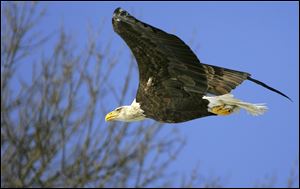
COMMENTARY
Glimpse of bald eagle awesome
Excitement has to be measured; raptors sensitive about nest area
3/4/2012
A bald eagle in Bellevue, Iowa, takes its catch and tucks it away for the flight to a nearby tree.
DUNBRIDGE, Ohio -- Bob Getz has lived near the junction of Sugar Ridge Road and Carter Road in northern Wood County for 45 years. He has farmed this fertile ground, driven these rural routes, and witnessed the seasons change nearly 200 times out here.
In that block of time, Getz has encountered just about every representative of the wildlife community that inhabits this area. He's seen countless coyotes, deer, foxes, raccoons, possums, skunks, pheasants, hawks, rabbits, and a variety of birds, but never a bald eagle.
Until about 10 days ago.
Getz was driving just north of his property when he noticed a large bird with a striking presence. It was clearly not one of the turkey buzzards that frequent the area, finishing last in every beauty contest while they clean up road kill.
"This bird was right up by the road, so I got a real good look at it. It was definitely a bald eagle," said Getz. "This eagle was eating something dead, but I couldn't make out what it was. I was just surprised to see a bald eagle around here."
The encounter Bob Getz had with the national symbol of the United States is rare when viewed in the context of the past half century, when the bald eagle teetered on the brink of extinction before making a surprisingly strong comeback.
The bald eagle was once common along many of the shorelines and wilderness areas in the U.S., but habitat loss and the use of toxic pesticides caused the population to plummet. Chemicals sprayed on crops to control insects washed into the rivers and were absorbed into the fish in those waterways -- fish that are a primary food source for eagles.
After eating the contaminated fish, the bald eagles experienced widespread reproductive problems and their numbers crashed. At a low point in 1979, there were only four nesting pairs of bald eagles left in Ohio.
Aggressive action by conservationists and government agencies removed the dangerous pesticides from the environment, and the eagles started along the path to recovery. Their numbers have steadily increased, and recent surveys indicate the Buckeye State is now home to about 200 nesting pairs.
The Magee Marsh Wildlife Area and the Ottawa National Wildlife Refuge in Ottawa County have historically been prime bald eagle habitat, with concentrations of the large raptors found along these marshy areas of the Western Lake Erie shoreline and along the major rivers feeding the lake.
Getz had seen bald eagles over near Pemberville, where a pair have been nesting along the Portage River, but never out in the broad swaths of grain fields and patches of woods where he lives, well-removed from the waterway.
As their numbers continue to strengthen, encounters such as the one Getz recently experienced are becoming more common. Toledo attorney Jim Rogers lives a couple of miles north of Getz, and Rogers and his wife have seen a pair of eagles in the area regularly since the fall.
"I saw them circling above the pond out back," said Rogers. "They're usually pretty shy, but a couple of times they've been sitting on the power pole out by the road and they don't flinch when you come down the drive. They just sit there and you can look right at them -- they're incredible to see up that close."
When the tilapia Rogers had in his pond to control algae growth started a seasonal die-off last fall, he put the dead fish in his nearby garden. The fish disappeared, and all that was left were eagle tracks.
"You have to stop every time you see them, because you realize just how rare they were for a very long time," he said. "Everyone out here is really excited about seeing the bald eagles flying around the area. They are just remarkable to watch."
The folks that live near where Carter Road crosses Devils Hole Road and Middleton Pike are giving the eagles a lot of room, aware that the pair has built a nest in a tiny woodlot that is surrounded by large areas of open agricultural fields, and adjacent to a moth-balled horse farm.
In all likelihood, the eagles are a breeding pair with eggs in the nest. Eagles build their massive nests, called aeries, in the tops of tall trees to keep the eggs safe from harm. They often return to the same nest, adding material each year. Bald eagle nests as large as 9-by-20 feet and weighing more than 4,000 pounds have been documented.
Tom Graven, who lives on a property south of Rogers, said he saw the eagles engaged in intensive nest building activity in December, and that work continued until recently. He has also seen the eagles picking at a raccoon carcass in a nearby field after having apparently hauled it away from the side of the road.
Graven has also witnessed the eagles drinking from his pond, and said that when they come out of the woods they will often fly directly toward his house about a quarter-mile away, then bank and arc higher in the sky.
"It is just a very impressive bird, and when they are sitting out back and you get a real good look at them, you are always amazed at how big they are," he said.
"We're enjoying seeing them, but everybody's staying away from the nest and the woods, giving them plenty of space."
State biologists strongly encourage affording the eagles such sanctuary around their nests. A walking trail at Magee Marsh was closed recently to protect a newly established nest in the area.
Contact Blade outdoors editor Matt Markey at: mmarkey@theblade.com or 419-724-6068